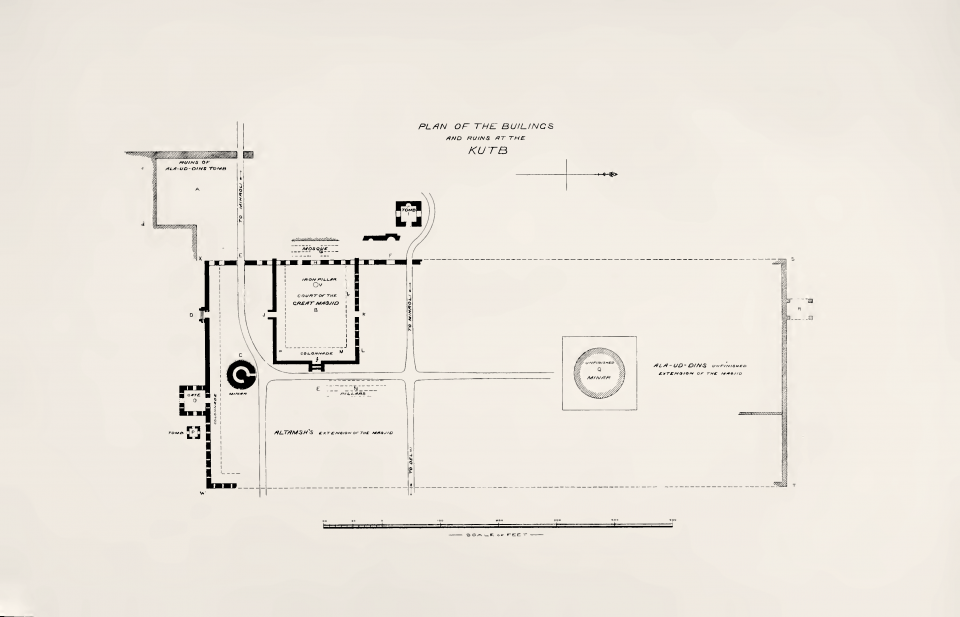A CLOSE examination of the different styles of ornament employed in the Colonnade will show both the remarkable versatility and fertility of invention possessed by the stone carvers in carrying out their designs. The simpler mode of merely incising the outline of the pattern occurs in the upper member of the centre pillar of this photograph. This kind of treatment, which I have every reason to believe is Hindu in origin, was undoubtedly appreciated by the Muhammadans. In the two side ranges of arches, built by Shanis-ud-din Altamsh, they have adopted that kind of ornament and carried it out in a still more simple way, being careful to maintain a greater flatness of surface.
In this view of the north-east corner of the Colonnade, may be seen in the background the steps leading to the pavilion at the angle (see M L on the plan and pages 36 and 38). The figures forming the cap or capital of the centre pillar may possibly be representations of Vishnu as a Brahmin dwarf. The legend runs that for the purpose of regaining possession of the earth and sea, over which a Rajah had acquired dominion, the god assumed the form of a dwarf; but the gods, fearing that even heaven would tall into the Rajah's hands also, Vishnu presented himself in the above-mentioned character and begged to have granted to him as much space as he could step over in three paces: the Rajah granted the request, believing that so diminutive a figure could not require much room for such a purpose. At the first step Vishnu cleared the whole earth; at the second he stepped over the ocean; as no space was left, he released the Rajah from his promise, on the condition of his retiring into Hell.
In connection with the casting operations which were carried out here, I may be allowed to mention that the safety of the moulds was considerably imperilled by the presence of a well filled and sleek Brahmin bull. This animal—regarded with great reverence by the Hindus, who were unceasing in their ministerings to his comfort—was permitted to take up his quarters every night amongst these pillars, naturally esteemed as objects of sanctity, having formed a portion of a sacred structure. As the casts were produced, and day by day accumulated on the spot, so it seems did the bull's wrath become kindled. At last one evening matters had evidently reached a climax for him, as I discovered him furiously goring the white plaster moulds. The next day I represented to the native villagers the inimicality to my work from a continued residence of the bull in the Colonnade; after a prolonged expostulation I obtained the promise of a remedy, and the bull's night lodging was changed.
![The Masjid-i-Kutb-ul-Islam [Quwwat-ul-Islam Mosque]. Pillars in the centre of the East Colonnade. The Masjid-i-Kutb-ul-Islam [Quwwat-ul-Islam Mosque]. Pillars in the centre of the East Colonnade.](https://architexturez.net/data/styles/large/public/media/masjid-i-kutb-ul-islam-pillars-north-east-corner-colonnade-delhi-1872.jpg?itok=eyGSWCk2)
